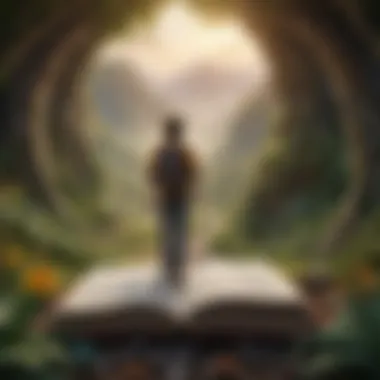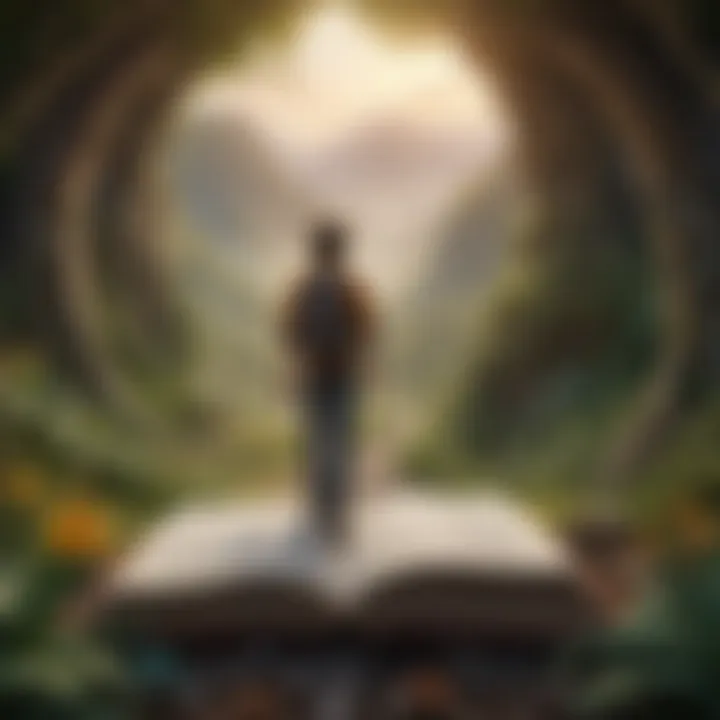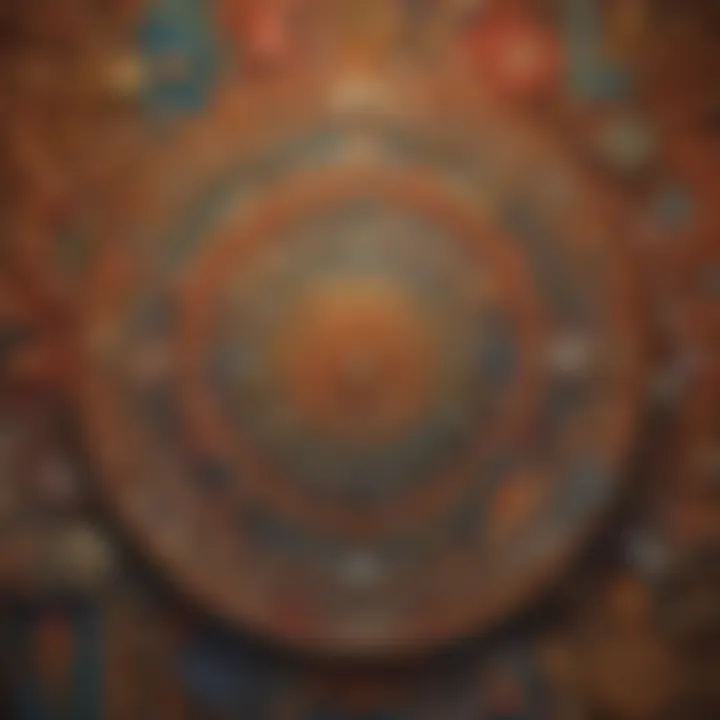The Philosophical Insights of Art of Living Books


Intro
In the fast-paced world we inhabit today, where distractions arise from every corner, the quest for meaning and personal growth stands more crucial than ever. Art of living books serve as guiding stars, illuminating paths toward enlightenment and self-understanding. These writings are not merely collections of words but rather profound expressions of thoughts that encourage readers to engage with life in a more meaningful way. As we journey through this exploration, we will dissect the major categories these books fall into, shedding light on their fundamental philosophies and the philosophical underpinnings that support them.
Book Categories
Delving into the realm of art of living books, we can categorize them into two primary areas: Fiction and Literature, and Self-Help and Personal Development. Each of these categories offers unique insights and approaches to living a fulfilling and thoughtful life.
Fiction and Literature
Fiction often provides allegories or narratives that reflect philosophical ideas related to existence, purpose, and morality. Through constructed worlds and characters, these works engage readers’ imagination, prompting reflections on their own lives. Several literary figures, such as Leo Tolstoy and Paulo Coelho, emerge as notable contributors to this genre, weaving life lessons within the tapestry of storytelling.
- Leo Tolstoy illustrates the importance of ethical living and personal integrity through novels like "Anna Karenina" and "War and Peace." His characters grapple with moral dilemmas that resonate with readers' experiences.
- Paulo Coelho’s works, particularly "The Alchemist," inspire individuals to pursue their dreams and embrace the journey, blending spirituality with practical wisdom.
Self-Help and Personal Development
On the other hand, self-help books directly address the intricacies of personal transformation. These texts aim to equip readers with tools and strategies necessary for self-improvement, emotional intelligence, and self-awareness. Influential writers like Dale Carnegie and Eckhart Tolle have left a significant imprint on this realm.
- Dale Carnegie's classic, "How to Win Friends and Influence People," delves into interpersonal skills and effective communication, fostering connections that enhance personal and professional ties.
- Eckhart Tolle’s "The Power of Now" emphasizes mindfulness and living in the present, steering readers towards a more conscious existence by shedding weighty pasts and anxious futures.
Book Summaries
In this segment, we will provide a concise summary of the profound insights gleaned from select texts within these categories, alongside practical ways to implement these lessons in daily life.
Key Insights and Takeaways
- The importance of intentionality: Both fiction and self-help literature share a common theme: being deliberate in one’s actions leads to richer life experiences.
- Interconnection of individuals: The narratives we encounter in fiction often mirror the collective human experience, highlighting our shared struggles and aspirations.
- Mindfulness and presence: As highlighted by Tolle, understanding the present moment can lead us down pathways of mental clarity and emotional stability.
How to Apply the Lessons
- Approach your day with intent: Write down your goals, however big or small, and strive towards them with purpose.
- Engage in reflective journaling: Notice patterns in your thoughts and behaviors, aiming for gradual improvement.
- Connect with others: Cultivate meaningful relationships by practicing active listening and empathy, as guided by Carnegie.
"Books are a uniquely portable magic." – Stephen King
These art of living books hold the potential to reshape our perceptions and attitudes. By understanding these texts' philosophical messages, readers can develop a heightened sense of self and a greater appreciation for the world around them.
Understanding the Art of Living
The Art of Living encapsulates a lifestyle and philosophy that encourages individuals to embrace their existence fully, engage in their immediate realities, and cultivate a sense of purpose and fulfillment. This segment of the article examines its significance, underlining the pivotal role that this understanding plays in fostering a deeper appreciation for life itself. The essential tenets of the Art of Living revolve around awareness, balance, and intentionality, all of which parallel the themes explored in various literature dedicated to this subject.
Understanding the Art of Living isn’t merely about the adoption of certain practices; it’s about comprehending the underlying philosophy that informs these practices. When individuals engage with the concept in literature, it lays a foundation for deeper introspection and growth. In essence, this philosophy acts as a compass, guiding individuals through the complexities of modern existence.
Defining the Concept
To define the Art of Living is to explore the myriad ways in which it reflects human experiences and aspirations. At its core, it is about living with intention, which translates into a myriad of practices—mindfulness, resilience, and joy, to name a few. The term can seem nebulous at first glance, but it becomes clearer with a closer look at its components.
- Mindfulness: This involves being present in the moment, fully experiencing life as it unfolds, rather than constantly revisiting the past or worrying about the future.
- Resilience: The ability to bounce back from adversity and adapt to changes embodies a key tenet of this philosophy.
- Joy: Cultivating an appreciation for simple pleasures enhances one’s outlook on life.
Each of these components holds significance in practical terms. When an individual learns to be here now, as many authors advocate, it transforms mundane moments into rich experiences. The Art of Living encourages thoughtful engagement with life’s complexities rather than a mere treadmill existence.
Historical Context
The Art of Living isn’t a modern invention. Its roots can be traced back to various philosophical traditions, both Eastern and Western. The ancient philosophies of Stoicism, for example, emphasized living in harmony with oneself whilst navigating the challenges posed by an unpredictable world. On the other side, Eastern traditions like Buddhism and Taoism stress the importance of understanding impermanence and the interconnection of all things.
Over time, these philosophies developed unique tendencies, yet they converge in their exploration of what it means to live well. This historical interplay has influenced countless works in Art of Living literature, where the blending of ideas creates a rich tapestry of insights.
"The greatest discovery of all time is that a person can change his future by merely changing his attitude."
—Oprah Winfrey


As we trace these influences, it's crucial to understand how contemporary writers distill ancient wisdom into modern advice. Authors process the past through contemporary lenses, ensuring their insights resonate with today's audiences. This balancing act between old and new is crucial in understanding how literary works reflect the evolution of the Art of Living throughout history.
Key Themes in Art of Living Literature
The themes found in Art of Living literature form the backbone of its philosophy. Each theme provides not just a concept or idea, but also serves as a lens through which readers can view their own lives. Understanding these key themes is crucial, as they highlight transformative practices that have profound impacts on personal growth and self-understanding. By delving into these concepts, one can grasp how they interconnect, and begin to weave them into daily existence to foster a richer, more fulfilling life.
Mindfulness and Presence
Mindfulness is often regarded as the cornerstone of living well. It emphasizes a return to the present moment, urging individuals to experience life fully as it unfolds. This idea resonates across various philosophies, underpinning many practices related to meditation and self-awareness. When we practice mindfulness, we distance ourselves from the incessant chatter of the mind — the regrets of past mishaps or worries about tomorrow. By concentrating on the now, we learn to truly savor our existence.
In contemporary terms, practicing mindfulness can lead to several benefits. It reduces stress, enhances emotional regulation, and improves focus. One may find that even simple activities like eating or walking become enriched when performed mindfully. This theme invites the reader to consider how deeply present they are in their own daily life. What flavors do they miss while eating? What sights go unnoticed during their daily commute? Towards understanding the intricacies of mindfulness, books in this genre often guide readers through exercises designed to cultivate awareness and appreciation for the moment.
"Mindfulness isn’t just a practice; it’s a way of life that leads to a deeper connection with oneself and the world around."
Resilience and Adaptability
Resilience refers to the capacity to bounce back from adversity. In a world where change is the only constant, adaptability becomes a requisite skill for survival. Literature centered around the art of living often emphasizes these qualities, showing how individuals can withstand life’s challenges and come out stronger. This theme addresses the reality that hardships are an intrinsic part of life, mobilizing readers to build emotional and mental fortitude.
Moreover, developing resilience doesn’t mean denying emotions. Instead, it encourages acknowledging feelings while strategizing towards growth. The ability to adapt is equally essential—life rarely goes according to plan, and a flexible mindset can mean the difference between stagnation and progress. Readers are encouraged to embrace change rather than resist it, recognizing that each twist and turn can offer a new lesson or opportunity.
Books that discuss resilience often share real-life accounts, illustrating how ordinary individuals have navigated complex situations. These narratives motivate readers to rethink their own obstacles and consider how they might apply similar principles in their lives.
Joy and Contentment
Joy and contentment represent the ultimate goals of many philosophies discussed within Art of Living literature. Unlike the fleeting nature of happiness, which often hinges on external circumstances, joy stems from within. It is about finding peace in the everyday, amid chaos and uncertainty. Contentment relates closely to gratitude; appreciating what one has rather than always reaching for more.
The teachings often point out that joy can be found in mundane moments—be it savoring the warmth of morning coffee or enjoying a quiet evening. This perspective invites individuals to look inward, reminding them that true fulfillment often lies in simple experiences. For those on a quest for deeper satisfaction, this theme encourages introspection about what brings lasting joy and fulfillment.
In sum, the key themes of mindfulness, resilience, and joy weaved throughout Art of Living literature provide invaluable insights for engaging more fully with life. Embracing these principles offers a road map for readers striving to enhance their lived experiences and cultivate a deeper appreciation for the world around them.
Notable Authors and Their Contributions
Exploring the contributions of notable authors is central to understanding the philosophy behind art of living books. These writers have crafted essential narratives that not only invite readers to reflect on their existence but also offer practical wisdom that can profoundly influence decisions and behavioral patterns. Their works often serve as a compass for those grappling with the complexities of life, as they distill multifaceted concepts into accessible language. Each author brings a unique voice, but what they collectively achieve is a universal reach that touches on the essence of human experience.
Eckhart Tolle: Presence and Awareness
Eckhart Tolle is perhaps one of the most recognizable figures among modern spiritual writers. His book, The Power of Now, emphasizes the significance of mindfulness and being present in the moment. Tolle's philosophy challenges readers to step outside their incessantly swirling thoughts and focus on what is real and tangible in their immediate environment. He posits that much of human suffering arises from inappropriate attachments to past regrets or future anxieties.
Some key points from Tolle's teachings include:
- Awareness of Breath: Tolle recommends simple techniques such as focusing on one’s breath to anchor oneself to the present, helping to break the cycle of overthinking.
- Ego and Identity: He discusses how much of our identity is tied to ego, which leads to a sense of separateness. By recognizing this, individuals can foster a more profound connection with others and with the universe.
- Acceptance: Emphasizing acceptance of the present moment as it is, Tolle suggests this leads to a newfound freedom.
"Realize deeply that the present moment is all you ever have. Make the Now the primary focus of your life."
— Eckhart Tolle
Deepak Chopra: Mind-Body Connection
Deepak Chopra presents an integration of science and spirituality through his emphasis on the mind-body connection. His extensive body of work underscores the importance of holistic health, advocating for a balanced approach to wellness that incorporates physical, emotional, and spiritual well-being.
Several highlights of Chopra's philosophy include:
- Meditation Practices: He is a staunch advocate for meditation, suggesting it not only alleviates stress but also opens pathways to self-awareness and emotional healing.
- Health and Wellness: He introduces concepts like Ayurveda and encourages a lifestyle that nurtures both the body and spirit, promoting a sense of unity between them.
- Quantum Healing: Chopra frequently discusses how consciousness influences the body, merging insights from various fields, including quantum physics, into a coherent philosophy of healing.
Chopra's work serves as a guide for those seeking a more fulfilling and health-conscious life.
Mihaly Csikszentmihalyi: Flow State
Mihaly Csikszentmihalyi introduced the concept of 'flow', which describes a state of complete immersion and enjoyment in an activity. His book Flow: The Psychology of Optimal Experience explores how to harness this state to enhance daily living.


Important elements of Csikszentmihalyi's theory include:
- Characteristics of Flow: He identifies key components that constitute flow, including clear goals, immediate feedback, and a balance between perceived challenges and one’s skill level.
- Applications in Life: This concept can be relevant across various domains, from work to hobbies, showing how individuals can significantly boost satisfaction and performance.
- Art and Creativity: Csikszentmihalyi emphasizes the role of flow in artistic endeavors, suggesting that it’s essential for creative output.
By understanding and applying the principles of flow, readers can cultivate deeper engagement and fulfillment in their daily lives.
Cultural Perspectives on Living Well
The exploration of how different cultures approach the idea of living well is not just academic; it has practical implications that resonate deeply with the modern individual. This section seeks to shed light on the varied interpretations and practices surrounding the concept of well-being, which can ultimately foster a richer understanding of personal growth and fulfillment. By examining both Eastern and Western philosophies, we can gain insights that enrich our own lives and offer varied strategies for navigating challenges.
Eastern Philosophies
Eastern philosophies, most notably manifested in traditions like Buddhism, Hinduism, and Taoism, emphasize a holistic approach to life that integrates mental, physical, and spiritual health. These cultures advocate for a balanced existence, where inner peace and mindfulness are central.
- Mindfulness: A cornerstone of many Eastern teachings, mindfulness is about being present in the moment and fully engaging with one’s surroundings. This practice encourages individuals to detach from past regrets and future anxieties, fostering an appreciation for the now.
- Interconnectedness: Eastern thought often frames existence in terms of interconnectedness — a view that promotes empathy and compassion. Understanding that one's actions affect the broader community can lead to more ethical choices and a sense of responsibility towards all living beings.
- Stoic Acceptance: The idea of accepting things we cannot change aligns closely with Eastern philosophies. Many belief systems here encourage individuals to embrace life’s natural flow, suggesting that surrendering to the inevitable can lead to inner serenity.
- Meditative Practices: Meditation, a common thread in various Eastern traditions, is not merely a tool for relaxation. It's viewed as a transformative process, allowing practitioners to delve deeper into self-awareness and insight.
"To know oneself is to be enlightened, for it reflects the path to harmony with the universe."
Western Approaches
In contrast, Western philosophies often focus on the individual as a distinct entity, promoting concepts of personal achievement and self-actualization. Despite this individualistic tilt, many Western traditions have also started to integrate insights from Eastern philosophies, leading to a more blended understanding of what it means to live well.
- Rational Thought: Many Western disciplines emphasize analytical thinking and logic. This rational approach can provide frameworks for understanding personal goals and aspirations on a deeper level. By systematically breaking down challenges, individuals can take measured steps toward improvement.
- Personal Empowerment: There's a strong culture of self-improvement in the West, often encapsulated in the idea that one can shape their destiny through hard work and determination. This ideal encourages individuals to take charge of their circumstances but can also lead to undue pressure and unrealistic expectations.
- Therapeutic Practices: Psychology in the West has played an extensive role in shaping contemporary views on well-being. Techniques such as cognitive-behavioral therapy emphasize the importance of thoughts in influencing emotions and behaviors, paving a path for individuals to reshape their realities.
- Community Orientation: Although often seen as individualistic, many Western thinkers and movements recognize the importance of community and social responsibility in achieving personal fulfillment. This perspective advocates for a balance between self-interest and the greater good.
In essence, cultural perspectives on living well highlight that there isn't a one-size-fits-all approach. Different systems of thought offer valuable insights that can be harmoniously blended, allowing individuals to craft their own unique paths toward a fulfilling life. Whether embracing the mindfulness of Eastern traditions or the self-empowerment motto prevalent in the West, individuals can find inspiration that resonates with their personal experiences.
The Impact of Art of Living Books on Readers
The influence of Art of Living books reaches far beyond mere word pages; it resonates deeply within the minds and hearts of readers. These texts carry a certain weight, encouraging individuals to reflect on their lives, beliefs, and choices. They act as gentle nudges, pushing one toward self-awareness, emotional intelligence, and personal growth. Delving into this impact reveals specific elements that contribute significantly to the benefits gained from these works.
Psychological Benefits
The psychological advantages of engaging with Art of Living literature can be profound. Many individuals find themselves grappling with stress, anxiety, and the chaotic pace of modern life. Here’s how these books help:
- Enhanced Emotional Resilience: Encountering the teachings within these pages often provides readers with coping mechanisms for difficult moments. Authors like Eckhart Tolle emphasize the present moment, teaching readers to anchor themselves rather than getting swept away by worries about the future or regrets from the past.
- Increased Self-Awareness: The introspective nature of these texts fosters self-reflection. Readers are often prompted to confront their own beliefs and values, which can lead to greater clarity about their motivations and needs. It’s like holding a mirror to one’s soul and seeing weaknesses or strengths that were previously unnoticed.
"In a time of uncertainty, the ability to look within can be the light that guides us through darkness."
- Reduced Symptoms of Mental Health Issues: Those suffering from conditions like depression or anxiety may find solace in the affirmations and philosophies shared in these texts. For instance, Mihaly Csikszentmihalyi's concepts of 'flow' can offer a way to reframe everyday activities in a more positive light.
Exploring mindfulness practices which often accompany these philosophies can also help build a sense of calm and balance, allowing for a clearer perspective on everyday dilemmas.
Behavioral Changes
Beyond psychological shifts, the Art of Living books can lead to tangible behavioral transformations. When readers digest the insights offered, their actions often begin to align more closely with their newfound values and understanding. Key changes might include:
- Improved Interpersonal Relationships: Many readers report better communication skills and emotional intelligence after diving into these teachings. They learn to approach conversations with empathy and patience, fostering connections that are rooted in understanding.
- Healthier Lifestyle Choices: With an emphasis on integrative practices that often prioritize well-being, readers may find themselves gravitating toward healthier habits. This can include everything from dietary adjustments to regular meditation routines.
- A Greater Sense of Purpose: Reassessing one’s priorities can be a monumental shift for many. Readers may start making choices that align with their authentic selves, moving away from societal expectations and toward a life that resonates more deeply with their core values.
To summarize, the impact of Art of Living books on readers is multifaceted, yielding psychological benefits and prompting behavioral changes that enhance overall quality of life. By engaging with these profound narratives, individuals cultivate not only a deeper understanding of themselves but also a more enriching interaction with the world around them.
Contemporary Relevance
The modern world is a whirlwind of distractions, responsibilities, and rapid changes. In this environment, the philosophy encapsulated in art of living books feels more pertinent than ever. These writings not only tackle issues that resonate with our daily struggles but also provide a roadmap for achieving a balanced and enriched life.
Navigating Modern Challenges
Today's challenges are varied and complex. From the relentless pace of technological advancements to the mounting pressures of professional and personal lives, it often feels like we're constantly juggling flaming torches.


Art of living literature serves as a beacon of guidance. For instance, books by authors like Jon Kabat-Zinn emphasize the importance of mindfulness in managing stress. This approach encourages readers to remain present, to acknowledge their thoughts without judgment, and to recognize the transient nature of emotions.
Each of us has faced moments where staying grounded seemed impossible. However, incorporating mindfulness techniques fosters resilience. Techniques such as meditation, deep breathing, and journaling are practical tools derived from these philosophies. They allow individuals to step back from chaos and assess their thoughts with clarity—like taking a breather during a wild storm.
Integrating Wisdom into Daily Life
Translating the wisdom from these texts into daily routines can feel daunting. But, it doesn't have to be a monumental task; small, incremental changes can lead to significant transformations.
- Set aside a few minutes each day for quiet reflection. This could be first thing in the morning or just before bed.
- Keep a gratitude journal. Recording what you’re thankful for can shift your mindset from scarcity to abundance.
- Establish tech-free zones at home, especially during meals or before sleeping. This helps create space for genuine connections.
Integrating these elements fosters an enriched quality of life. You begin to notice deeper interactions, a keen appreciation for the little things, and a more significant connection to your surroundings.
In summary, the contemporary relevance of art of living books is clear. As we wade through life’s complexities, these texts provide foundational pillars that support healthier, more fulfilling lifestyles. When we take the time to digest their teachings and weave them into our everyday living, we begin to illuminate our paths, even amid the darkest nights.
"In the midst of movement and chaos, keep stillness inside of you."
- Deepak Chopra
These philosophies are not merely relics of yesterday; rather, they are essential tools for today’s journey into self-discovery and fulfillment.
Future Directions in Art of Living Literature
The trajectory of art of living literature is an ever-evolving journey. With each passing day, new challenges, discoveries, and voices emerge, all shaping our understanding of personal growth and well-being. As we explore future directions, it becomes clear that these texts hold a mirror to society's changing ethos. They reflect not just individual experiences but also collective realities. This section aims to highlight the value of recognizing the future paths that art of living literature is taking, along with the implications of these shifts for readers seeking deeper self-awareness and growth.
Emerging Voices and Trends
In the contemporary landscape of art of living literature, several emerging authors are redefining the conversation around personal well-being and fulfillment. Consider the likes of people such as Jay Shetty, who draws upon his background as a monk to craft accessible advice for a mainstream audience. His narratives often highlight the intersection of ancient wisdom with everyday challenges, making ancient philosophies relatable for today’s seekers.
Moreover, there's a noticeable turn toward inclusivity in themes and practices. Voices from diverse backgrounds are stepping into the spotlight, sharing unique perspectives on mindfulness, resilience, and joy. This inclusivity not only enriches the literary tapestry but prompts readers to reflect on their personal narratives in the context of broader societal issues, like race, gender, and socio-economic status.
"The inclusion of various cultural perspectives fundamentally enhances the dialogue. It's not just about personal growth; it's about collective resilience in a rapidly changing world."
The trends also signal a movement towards practicality in teaching approaches. Readers are increasingly looking for actionable strategies rather than abstract philosophies, with a focus on how these can be integrated into everyday life. This push for pragmatism has encouraged authors to provide exercises, reflections, and even community support systems woven into their narratives.
Digital Transformation of Literature
In this digital age, the transformation of literature is hard to overlook. Art of living books are no longer confined to physical pages; they now thrive in online formats, audiobooks, and even interactive platforms. This shift has several benefits, notably accessibility and engagement. Readers can access a wealth of resources at their fingertips, from podcasts discussing mindfulness to interactive webinars featuring prominent philosophers and life coaches.
Furthermore, social media platforms facilitate vibrant discussions around these texts. For instance, groups dedicated to discussing and implementing lessons from these works abound on platforms like Facebook or Reddit. These virtual communities encourage peer support, allowing individuals to share experiences and insights in real time.
The digital realm also opens doors for emerging voices who might not have access to traditional publishing avenues. Self-publishing and online discussions allow these new authors to gain visibility with relative ease. As a result, the discourse on living well continues to diversify and expand, offering multiple lenses through which readers can examine their lives.
In summary, the future of art of living literature is poised for an exciting evolution, driven by emerging voices, practical wisdom, and digital innovation. This landscape promises not only to enrich individual experiences but also to weave a collective narrative that resonates with diverse audiences.
Culmination
In closing, the exploration of the philosophy behind art of living books reveals a profound intersection of thought, culture, and personal growth. These works act as guides not just to self-help, but to a more enriched existence. As we navigate the busy lanes of modern life, the insights gleaned from these texts can foster clarity, making complex emotions and thoughts more accessible.
Reflecting on Insights Gained
Understanding the philosophies underpinning these books allows readers to reflect more deeply on their personal journeys. This reflection can aid in recognizing patterns—both beneficial and detrimental—in one’s life. For example, many readers have reported that revisiting mindfulness practices introduced in Eckhart Tolle's works led to enhanced awareness and a reduction in anxiety. This is not just about absorbing knowledge; it's about creating a filter through which to interpret day-to-day experiences. As readers, we are encouraged to tap into an inner reservoir of wisdom, thus leading to practical insights that inform daily decisions.
- Awareness of Self: By acknowledging where we stand within our own narratives, we develop a stronger sense of individual agency.
- Cultural Relevance: The teachings often reflect diverse cultural backgrounds, broadening understanding on a global scale.
- Actionable Steps: This body of literature often provides step-by-step guides for incorporating these principles into life, engendering real change.
"The only journey is the one within." - Rainer Maria Rilke
The Ongoing Journey of Self-Discovery
Self-discovery is an ongoing process; it isn’t a destination but a continual unfolding. Through art of living literature, each reader is prompted to dive deeper into their psyche and confront the truths that they might have previously overlooked.
The commitment to self-discovery can appear daunting, yet it invites a gentle kind of exploration. As depicted in Mihaly Csikszentmihalyi’s concept of ‘flow’, moments of engagement can be transformed into deeper realizations about one’s own values and aspirations. By regularly engaging with these texts, readers build a habit of introspection that enriches their understanding of life’s complexities.
- Sustained Growth: Rather than hitting a plateau, followers of these philosophies find new layers to explore.
- Transformative Practices: Incorporating practices such as meditation or reflective journaling makes self-discovery actionable and relatable.
- Community and Discussion: Engaging with others who share similar interests in these texts can also cultivate deeper insights, fostering a supportive community around shared journeys.
Thus, as one reflects upon their journey, it becomes clear that the teachings within art of living literature are not the end—they’re merely stepping stones on a larger path toward fulfillment. By embracing these texts wholeheartedly, one can navigate life's ebbs and flows with renewed vigor and perspective.



